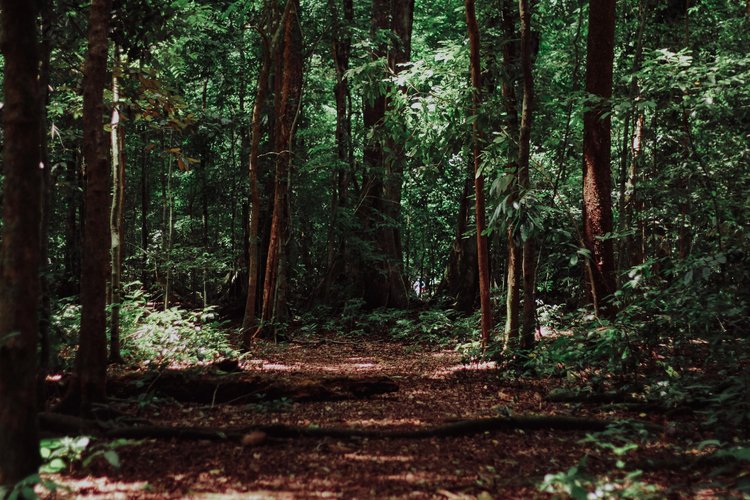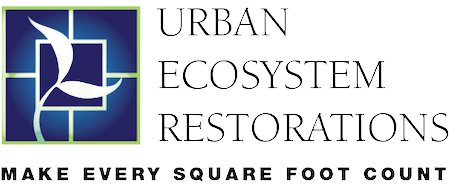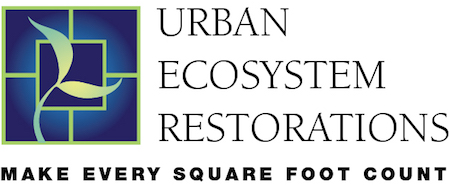A Greater Community

How Urban Tree Communities foster life, enhance equity, and cultivate resilience in urban spaces
by Jack Mangan
In this age of doom scrolling, seemingly never-ending natural disasters, and the overall sense of impending calamity, it becomes all too easy to become overwhelmed. Fortunately, there are innovative projects and strategies that harness the power of nature to provide climate mitigation and adaptation to the consequences of the climate crisis – including in urban spaces where these extreme consequences affect millions of people. In addition to UER’s projects in the Washington, D.C. area, projects like Trees for Cities (https://www.treesforcities.org/) and Tiny Forests (https://earthwatch.org.uk/get-involved/tiny-forest) provide far-reaching environmental and social benefits by incorporating Urban Tree Communities. Urban Tree Communities are vital components of ecosystems and crucial to addressing the impacts of our global climate crisis (Safford et al. 2013).
“Urban Tree Communities” are stands of trees, native to the local ecosystem, that exhibit processes and contain sufficient characteristics to mimic the natural processes of native forests. Examples of this collection of conditions vary widely but may include combinations of an underground and interconnected root network, access to a water table, means of reproduction, and observable layers of succession (i.e., the natural progression of plant types existing in an area over time). The term “Urban Tree Community” encompasses several types of urban greenery: urban forests and forest fragments — and even small groves of trees — often constitute the makings of an Urban Tree Community, particularly as they reach sufficient size, health, and interrelationships to mimic forest hydrology, structure, canopy cover, and regeneration.
Individual trees, whether placed in planters, tree boxes, or otherwise secluded from other trees do not constitute Urban Tree Communities. Trees outside of Urban Tree Communities still provide numerous health and ecological benefits, but they lack the conditions to establish the connections required for healthy tree communities (and therefore, cannot attain the same level of ecological or ecosystem service benefit). Acknowledging the communal structure of urban forests allows a more holistic understanding of their optimal place within cities and the benefits they can provide. Much like us, trees require communities to live full, healthy lives.
At UER, we recognize how vital these spaces and natural communities are to the areas we live and work. These Tree Communities provide essential environmental, economic, and equitable services to urban spaces, many of which are summarized below and many of which have been lost to certain neighborhoods for far too long.
Environmental
· Tree Communities assist in the purification of air and water, improving quality and, as a result, human health. (Roeland et al. 2019)
· Tree Communities reduce temperatures associated with the Urban Heat Island effect through the natural processes of evapotranspiration, the provision of shade, and increased albedo. (Roeland et al. 2019)
· Tree Communities vastly increase biodiversity within cities, supporting the lives of countless insect species, offering havens for migrating birds, and providing sustenance for small mammals. (Roeland et al. 2019)
Economic
· Tree Communities reduce the damage caused by extreme storm events, decreasing the severity of flooding through improved rates of infiltration and retention (https://www.epa.gov/sites/default/files/2015-11/documents/stormwater2streettrees.pdf)
· The planting and maintenance of Tree Communities provide both employment and education opportunities for the neighborhoods they grow in (https://www.arborday.org/trees/bulletins/coordinators/resources/pdfs/060.pdf)
Equity
· The equal distribution of Tree Communities in urban spaces assists in the bridging of disparities in the provision of shade, the extent of noise, air, and water pollution, increased resilience to severe storm events, and the offering of recreational opportunities (https://www.americanforests.org/tools-research-reports-and-guides/research-reports/climate-change-urban-forests/)
What can we do?
How can we as stewards of the environment contribute to the establishment of Tree Communities in our own neighborhoods? Outlined below are various programs found throughout Maryland, Washington D.C., and at a national level.
Local Volunteering Opportunities
· Tree-Mendous Maryland – organizes plantings statewide and provides guidance for local volunteers to assist in restoring tree coverage across Maryland. https://dnr.maryland.gov/forests/Pages/treemendous/default.aspx
· Casey Trees – Organization that provides planting and involvement opportunities for DC tree conservation. https://caseytrees.org/
· Alliance for the Chesapeake Bay – organization for the stewardship of the Chesapeake Bay Watershed. https://www.allianceforthebay.org/
· Healthy Forests Healthy Waters – a collaborative effort to increase tree planting across multi-jurisdictional organizations. https://www.allianceforthebay.org/project/healthy-forests-healthy-waters/
State and Local Incentives
· RiverSmart Homes Shade Tree Planting – DOEE program that provides free plantings for DC residents. https://doee.dc.gov/service/riversmart-homes-shade-tree-planting#:~:text=RiverSmart%20Homes%20will%20plant%20shade,that%20are%20offered%20to%20residents.
· Woodland Incentive Program – provides financial aid for landowners for the revitalization of forested areas. https://kentsoilandwaterconservationdistrict.org/our-programs/woodland-incentive-program/#:~:text=The%20Woodland%20Incentive%20Program%20provides,the%20goods%20and%2For%20services.
· Maryland Forest Conservation Program – provides tax-based incentives for the implementation of conservation-based forest management practices. https://dnr.maryland.gov/forests/pages/programapps/fcmp.aspx
· Maryland Environmental Quality Incentive Program – provides financial and technical assistance for landowners to implement conservation practices. https://www.nrcs.usda.gov/programs-initiatives/eqip-environmental-quality-incentives/maryland/environmental-quality
· Maryland Conservation Reserve Enhancement Program – provides financial incentives for the implementation of conservation practices. https://mda.maryland.gov/resource_conservation/Pages/crep.aspx
· Maryland Farm Stewardship Program – provides financial and technical assistance for landowners to implement conservation practices. https://www.nrcs.usda.gov/programs-initiatives/csp-conservation-stewardship-program/maryland/conservation-stewardship-program
National Programs
· The Nature Conservancy’s Plant a Billion Trees Campaign – Nationwide forest restoration program. https://www.nature.org/en-us/get-involved/how-to-help/plant-a-billion/
· National Forest Foundation Tree Planting Campaign – initiative for the restoration of national forests. https://www.nationalforests.org/tree-planting-programs
· Arbor Day Foundation – organization for forest science, community resilience, and conservation science. https://www.arborday.org/
· U.S. Forest Service Plant-A-Tree Program – planting program for groups and individuals to contribute to the U.S. Forest Service’s mission for tree planting. https://www.fs.usda.gov/working-with-us/donations/plant-a-tree
· National Wildlife Federation Trees-for-Wildlife Program – educates the public about the role trees play in the environment and community, and how individuals can contribute. https://www.nwf.org/Trees-for-Wildlife/About#:~:text=Trees%20for%20Wildlife%E2%84%A2%20educates,locally%20and%20across%20the%20nation.
Tools
There exist plenty of tools to take on your own tree planting project, in order to foster life in your own backyard. Below are several, including native species lists, educational and reference information, and more.
Interactive Street Tree Map, Washington D.C. – provides information regarding species distribution and location in Washington, D.C. Can be referenced in order to identify planting needs. https://caseytrees.org/resources-list/d-c-street-trees-map/
Maryland Riparian Buffer Care Calendar – assists in the understanding and care for early establishment of Riparian Buffers. https://dnr.maryland.gov/forests/Documents/MD-Riparian-Buffer-Care-Calendar.pdf
Maryland Forest Service Shelter and Seeding Maintenance – Reference guide for early tree care. https://dnr.maryland.gov/forests/Documents/Shelter-Maintenance.pdf
Urban Forestry D.C. Outreach Page – Tree maps for greater D.C., as well as goals plantings, needs assessments, action plans, and more. https://ddot-urban-forestry-dcgis.hub.arcgis.com/pages/outreach
Conclusion
The above projects, programs, and materials only scratch the surface of the opportunities available for the creation of Urban Tree Communities across the country. And fortunately, we all have the ability to make a difference during uncertain times. Sowing the foundations of Urban Tree Communities can offer solace for generations to come. As a new year fast approaches, UER encourages you to make 2023 a year of celebration for Urban Tree Communities.
Further Reading
The opportunities to learn and grow alongside your local Tree Communities are endless and expanding every day. Below are some further readings that may interest the curious environmentalist.
- “Nature’s Best Hope: A New Approach to Conservation That Starts in Your Yard” by Douglas W. Tallamy
- “The Hidden Life of Trees” by Peter Wohlleben
- “Biophilic Cities” by Timothy Beatley
References
Roeland, S., Moretti, M., Amorim, J.H. et al. Towards an integrative approach to evaluate the environmental ecosystem services provided by urban forest. J. For. Res. 30, 1981–1996 (2019). https://doi.org/10.1007/s11676-019-00916-x
Safford, H.; Larry, E.; McPherson, E.G.; Nowak, D.J.; Westphal, L.M. (August 2013). Urban Forests and Climate Change. U.S. Department of Agriculture, Forest Service, Climate Change Resource Center. www.fs.usda.gov/ccrc/topics/urban-forests

